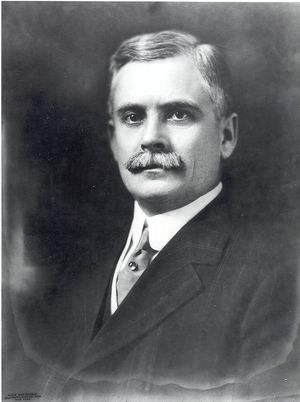Bion J. Arnold
- Birthdate
- 1861/04/14
- Birthplace
- Casnovia, MI, USA
- Death date
- 1942/01/29
1903 -1904
Bion J. Arnold, AIEE President, 1903 - 1904, pioneered street railways in numerous cities across the United States, and he helped to bring electricity to New York’s Grand Central Station. In addition to his work on railways, Arnold also invented a magnetic clutch and improved storage batteries.
Biography
Throughout the long and eminently successful career of Bion Joseph Arnold, his initiative, ingenuity and resourcefulness have been recognized by not only his fellow engineers, but also by the general public who know him well for his inventions, extensive consulting practice and the installation and direction of numerous public utility services.
He was born at Casnovia, Michigan in 1861, and was educated in the Ashland, Nebraska public schools, the University of Nebraska and at Hillsdale College, Michigan. He received the degrees B.S. from Hillsdale College, in 1884, and M.E., in 1887. Later he took a postgraduate course in electrical engineering at Cornell, and in 1897 he received the degree E.E. from the University of Nebraska, and, at various times, many honorary degrees.
In his boyhood, Col. Arnold constructed models of farm implements, a steam engine, steam plant, bicycle and, most remarkable a working model of the standard Burlington locomotive, complete in all details and 1/16 full size. The locomotives which entranced him as a child drew his interest as a young man to the railroad and its problems. Fame first came to him in 1893 by the design and building of the Intramural Elevated Railway at the Columbian Exposition, in Chicago. This was the first commercial installation of the third rail on a large scale, and it led to a wide practice as consulting engineer for steam and electric railways. From 1902 to 1907, he was Chicago’s consulting engineer and was thus responsible for overseeing the construction of their street railways. Later, he did the pioneer work of installation for such roads as the Chicago, Milwaukee Electric Railway, and the Lansing, St. Johns and St. Louis Railway, in Michigan, and other transportation systems in San Francisco, Pittsburgh, Toronto, and Providence. For the latter, he developed in 1900 an a-c single-phase system. He converted from steam to electrical operation the Grand Trunk Railroad through the St. Clair Tunnel from Port Huron, Michigan to Sarnia, Ontario. The single phase high-voltage system for heavy electric railway work was adopted here for the first time.
Other important commissions Col. Arnold carried out where the development of the electrification of the Grand Central Terminal, New York, and the development of the subway system of New York, a task that Arnold worked on for five years and which cost 60 million dollars. He has been consultant on surface and underground traction matters at various times for cities all over the country, and consulting engineer for numerous railroad commissions. In addition to his critical work on railways, he invented a magnetic clutch and improved storage batteries. He maintained headquarters at Chicago.
During World War I, Col. Arnold served in various capacities, being assigned as Lieut. Col., Aviation Section, 1917, to make a complete survey of aircraft supply and production conditions for the Army and Navy, and to take charge of the development and production of aerial torpedoes. In 1925, he was commissioned as Col. Auxiliary Corps. Arnold served the Institute on various committees and was president of the AIEE in 1903 and 1904. He was a member of numerous other societies, among them, the American Society of Civil Engineers, the American Society of Mechanical Engineers, Western Society of Engineers, and the American Society for Promotion of Engineering Education.
Further Reading
